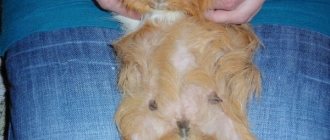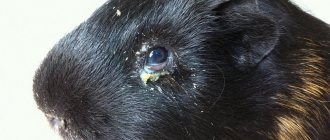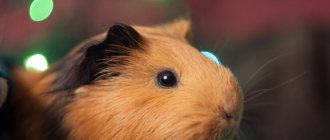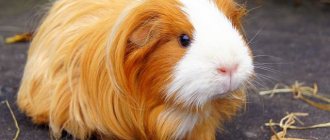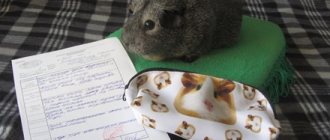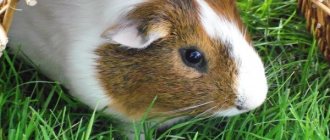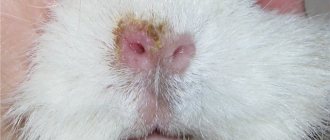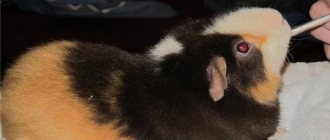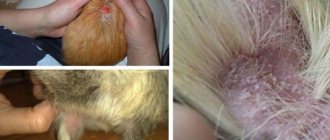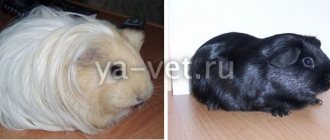Among the diseases of guinea pigs, there are some that are not very common, but every breeder should know about their symptoms. Cheilitis or cheilosis is one of the diseases that manifests itself in damage to the lips and the formation of purulent ulcers on them. Cheilitis has several varieties and can lead to serious consequences - exhaustion of the body, digestive problems and liver and kidney diseases.
Causes of the lesion
Cheilitis can be a manifestation of other health problems or act as an independent disease. Conventionally, the causes of damage are divided into the following:
- Hypovitaminosis or hypervitaminosis
- Actinic
- Allergic
- Fungal
- Viral
- Contact
- Food
In the first case, cheilitis becomes a manifestation of a lack of pantothenic acid, as well as vitamins A and C. The opposite situation is also possible. The food may contain excess synthetic vitamin C, which leads to inflammation of the mucous tissues.
In guinea pigs, ultraviolet sensitivity is rare, but it can also cause swelling and crusts on the lips. An allergic reaction can occur to chemicals in foods, dust or pollen.
A common cause of cheilitis is a fungal infection caused by Candida albicans. Some veterinarians have reported cases of infection with the herpes virus, which led to a similar condition.
Some types of mites that live on the roof of a guinea pig can also lead to the same condition. Contact with acidic foods can irritate the mucous membranes of the lips and lead to microcracks, and then to inflammation. An imbalance of essential fatty acids and an excess of sugars in food can also lead to injury and inflammation. In general, very often a decrease in general immunity, the presence of stress, and an unbalanced diet often manifest themselves in the form of disorders of the skin and teeth.
Forms of cheilitis
Cheilitis is the name of a whole group of diseases of the teeth and lips. The causes of the disease are different, and the term itself most often denotes a diagnosis and a specific inflammatory process. Most often, the catal form of cheilitis is caused by various injuries, chemical burns and sudden changes in weather. The first symptoms of such cheilitis are the formation of inflammation, redness, swelling and peeling of the skin on the lips. The granular form of the disease manifests itself in inflammation of the mucous glands of the lips. In sick animals, the glands become enlarged, and purulent abscesses appear on the lips.
The main danger of inflammation is that a cyst may form on the lips, which means that normal food intake will become impossible.
At the first symptoms, you should immediately consult a doctor to remove the inflammation.
The exfoliative form of the disease manifests itself in severe swelling of the lips and the appearance on them of many pustules with grayish-yellow crusts. The disease can be caused by improper feeding, too rough or dirty feed, and can also be infectious. Eczematous cheilitis appears with frequent trauma to the surface of the lips and a deficiency of vitamins A, C and B. Dental diseases cause the candidal form of cheilitis.
Treatment Options - Nutrition
Depending on the severity and causes of the disease, treatment may vary. First of all, you need to take care of your diet. You should temporarily exclude juicy sour and sweet and sour vegetables and fruits. Their juice will further injure the inflamed mucous tissue. An important element of nutrition remains not juicy vegetables, a variety of herbs, twigs, and hay.
To replenish vitamins, fats, micro- and macroelements, you should add 3-4 pieces of peeled sunflower seeds throughout the week. They are healthy thanks to Omega-6 fatty acids.
You should give your pet flax seeds in a volume of 1/2 teaspoon for a week. They contain Omega-3 fatty acids, so the seeds will provide the necessary amount of nutrients.
It is also permissible to moisten the food with drops of sesame or flax oils.
We wrote in more detail about proper nutrition for guinea pigs in this article.
Diseases of guinea pigs by age
Alas, guinea pigs are rodents with an intense metabolism and a fairly short life span.
By old age (which comes quickly), they accumulate a whole bunch of age-related diseases.
Newborn diseases
Diseases of newborn animals include:
- Rickets. It happens extremely rarely and only in cases where the mother receives absolutely terrible, inadequate and completely unbalanced nutrition.
- Conjunctivitis. Usually develop against a background of poor sanitary conditions. Simply put, they threaten the animals, whose cages are very rarely cleaned (ammonia literally eats their eyes out).
- Diarrhea of various etiologies. Perhaps they are the most dangerous, since babies can die from dehydration within just a couple of hours.
- Hair loss. Often due to the same poor-quality nutrition of the mother (the result is milk without vitamins and microelements).
Symptoms and first signs:
- The cubs are inactive and lethargic.
- A very dangerous symptom is a decrease in body temperature. This indicates severe dehydration, which is often fatal.
- Refusal to eat, they practically do not “suck” the mother.
- Discharges from the eyes and nose are visible. Since the dried exudate clogs the nasal passages, the small pet sniffles and puffs when breathing.
- The nest is full of liquid feces, and the smell is appropriate.
- At the same time, the skin of the pig becomes flabby, the skin acquires a parchment texture. This indicates severe dehydration.
Diseases of old animals
Almost always, diseases of old animals are closely related to their advanced age:
- Osteoporosis. Occurs in animals with very poor nutrition.
- Arthritis and arthrosis.
- Spinal pathologies.
- Veterans often have eye problems (glaucoma).
The symptoms are similar to those described above:
- The pet is lethargic and inactive.
- Lameness is often observed, and the animal may drag its paws.
- Touching sore limbs causes severe pain to the pet. The pig squeaks and some animals begin to bite.
- In the mornings, the “old man” tosses and turns for a long time, but cannot get up. Sometimes the pig begins to crawl closer to the feeder, moving its front paws. After a few minutes, when the muscles and joints warm up, the animal will be able to stand up again, but for the first hour or hour and a half it will walk like wood.
- The old pig has a dull look, and sometimes there are noticeable thorns in the eyes. Due to poor vision, the animal constantly bumps into all the objects in the cage.
Treatment options - medications
Remember! Only a veterinarian can prescribe complete treatment.
The regimen will depend on the causative agent of the disease, which is determined by a special analysis. For these purposes, scraping is carried out from the skin to conduct samples of biomaterial with special chemicals.
The duration of treatment can reach several weeks. As a rule, cure occurs on the 14th day. Cream or ointment should be applied to the damaged area 2-3 times throughout the day.
In some cases, drugs with antifungal or antibacterial effects are used. The type of main substance of the drug depends on the pathogen.
An example of medicines from pharmacies for humans could be the following ointments and creams:
- Terbinafine 1%
- Bepanten
- Clotrimazole
- Lorinden S
- Candide
The following products are purchased at veterinary pharmacies:
- Panologist
- Surolan
- Imaverol
Before applying ointment or cream, it is recommended to treat the affected area with an antiseptic. This could be a decoction of chamomile, chlorhexidine, octenisept or miramistin.
If the cause of the disease is ticks, then Ivomek is an effective drug.
For fungal forms, in addition to candida or clotrimazole, nystatin is often needed. It is strictly forbidden to remove scabs from a wound. With mechanical damage, inflammation may intensify, and the scales will grow again.
For cheilitis, which is localized on the teeth, yeast-like fungi are often the cause. External ointments should not be used in the mouth. Therefore, drugs are used against mold and yeast in the oral cavity.
To alleviate the condition, you can take your pet out into the fresh air under the sun's rays.
Did you like the article? Share with friends: [supsystic-social-sharing id=”1"]
- Related Posts
- Subcutaneous and ear mites in guinea pigs, symptoms and treatment
- Guinea pig's hair is falling out
- Guinea pig bites
« Previous entry
Main symptoms of cheilitis
Forms of cheilitis may differ in symptoms, but there are a number of symptoms that are characteristic of the disease as a whole:
- Formation of cracks and reddish or brown crusts on the lips,
- The appearance of yellow plaque on the teeth,
- The appearance of dark and hard deposits at the roots of teeth,
- Teeth moving in different directions
- The appearance of dark plaque between the teeth,
- Change in tooth enamel color
- Puffiness and swelling of the lips,
- Loss of appetite.
- Formation of ulcers on the lips.
- If the disease is advanced, ulcers and cracks may appear all over the face and nose.
Fungal, viral and oncological diseases
“Pigs” also suffer from fungal, viral and oncological diseases. All of them can be the root cause of pathologies of the kidneys, liver, heart and other systems mentioned above.
Tumors
In most cases, tumors develop in older pets. Their diversity is extremely large, but all neoplasms can be divided into two large types: benign and malignant. The following benign neoplasms are encountered in veterinary practice:
- Lipomas (from adipose tissue).
- Myomas (from muscle tissue).
- Adenomas (develop in the glands).
- In addition, fibroids are quite common in pigs (they grow from connective tissue).
Manifestations and stages
Cheilosis is a common inflammatory problem. When the lip tissue is damaged, signs such as increased dryness and redness, the development of wounds and ulcers, and pain appear. Often develops due to poor ecology, irritation caused by food or chemicals. In some cases, it is caused by other diseases, that is, it acts as a symptom.
The following types of lesions are observed in children:
- traumatic;
- exfoliative;
- contact;
- meteorological;
- grandular and angular cheilitis in children;
- microbial.
The traumatic form occurs due to mechanical, chemical and other influences, after which infection develops. Swelling appears, the mucous membrane becomes tense, and lip movements become limited. In some cases, this type of cheilitis is caused by herpes in the acute stage. For treatment, antibiotics, antiseptics or anti-inflammatory drugs are prescribed.
The exfoliative type of the disease is accompanied by increased dryness and peeling. The reason is a lack of vitamin B, ascorbic or nicotinic acid. The problem arises with dysfunction of the endocrine or nervous system, impaired lip closure, or mouth breathing. Therapy is prescribed depending on the cause of the lesion; multivitamins and softening creams are often used.
Allergic, or contact, cheilitis in most cases develops in adolescents. The causes are chemicals and other external factors. Manifestations of the disease include itching or burning, blisters on the surface, and dryness. To eliminate the problem, you need to avoid contact with the substance that caused the allergy and take antihistamines.
In addition, there are:
- atopic cheilitis in children, which is accompanied by peeling, swelling, erythema and edema;
- hypovitaminosis, characterized by cracks, soreness, the causes are bad habits, for example, frequent licking of lips;
- Eczematous cheilitis is not an independent disease, but one of the symptoms of an inflammatory process affecting the skin.
Main diseases by organs and systems
Note that age-related pathologies are rare for guinea pigs. It is better to consider diseases of specific organs and systems, since they can affect animals at any age.
Eye diseases
Eye diseases in pigs are not very diverse:
- Conjunctivitis, i.e. inflammation of the mucous membrane of the eye.
- Keratitis and glaucoma.
- In very rare cases - ulcerative lesions of the cornea.
The symptoms are as follows:
- The animal often suffers from photophobia, squints and moves away from any light source.
- The eyes are squinted and the eyelids may swell. Because of this, the pig almost never opens its eyes completely.
- Exudate constantly oozes from the eyes (it can be liquid, purulent or any other).
Dental diseases
- Poor bite due to overgrown incisors. Rodents' incisors grow constantly. If they do not wear off on hard food, the animal resembles a saber-toothed tiger. In these same cases, teeth can break off.
- Tooth loss. This is only possible if you have an extremely unbalanced diet.
- Caries, abscesses, pulpitis and other inflammatory pathologies.
- Dental cheilitis , i.e. fungal infection of teeth.
Symptoms
The main signs of the disease are:
- swelling, cracks;
- races forming in the corners of the mouth;
- peeling and dryness, a burning sensation;
- yellow or gray crusts;
- soreness, development of blisters from which pus can be released.
Diagnosis and treatment
The disease has a code of 10–K13.0, which determines the probable causes and symptoms. When the first signs appear, you should contact your dentist and pediatrician, which will help to identify problems in a timely manner, conduct a diagnosis and begin treatment. Early treatment allows therapy to be effective and to avoid worsening.
Treatment of angular cheilitis in children requires complex measures. Depending on the severity of the condition, antibacterial ointments or gels, immunostimulating agents, and multivitamin complexes are prescribed. The diet is adjusted to include more dairy products, fruits and vegetables. If persistent wound formation is observed, antibiotics are required. If there is no improvement, an additional appointment with specialized specialists, for example, a gastroenterologist, dermatologist and others, is recommended. For candidiasis, antifungal drugs are prescribed.
The treatment regimen usually includes:
- topical agents, gels or oil compresses on the affected area;
- anti-inflammatory drugs;
- ointments based on hormonal agents;
- sanitation of the child’s oral cavity;
- antibiotics;
- vitamin complexes;
- eliminating the causes of the disease;
- exclusion of factors that have a negative effect on tissue.
Prevention
The process of inflammation can be prevented by removing or minimizing negative external factors. It is necessary to teach the child to stop licking the corners of the mouth and lips, and to use hygienic lipsticks or gels when dry. For dry skin, it is permissible to use creams intended for children and adolescents.
As a preventive measure, you need to adjust your diet. It is recommended to exclude from the diet sour and spicy foods, too salty dishes that irritate the mucous membrane. It is necessary to increase the amount of non-acidic fruits and vegetables, foods with a high content of riboflavin and iron.
About Us
My Ort Dental Clinic offers services for the treatment of diseases in children. We provide the following benefits:
- offices equipped with modern technical equipment;
- comfortable conditions for Patients of any age;
- qualified children's specialists;
- comprehensive services, including diagnosis, treatment and monitoring of achieved results;
- favorable price.
You can visit us at the address: St. Petersburg, st. Yesenina, 1, building 1. We work seven days a week, you can make an appointment using a convenient form on the website or by phone.

